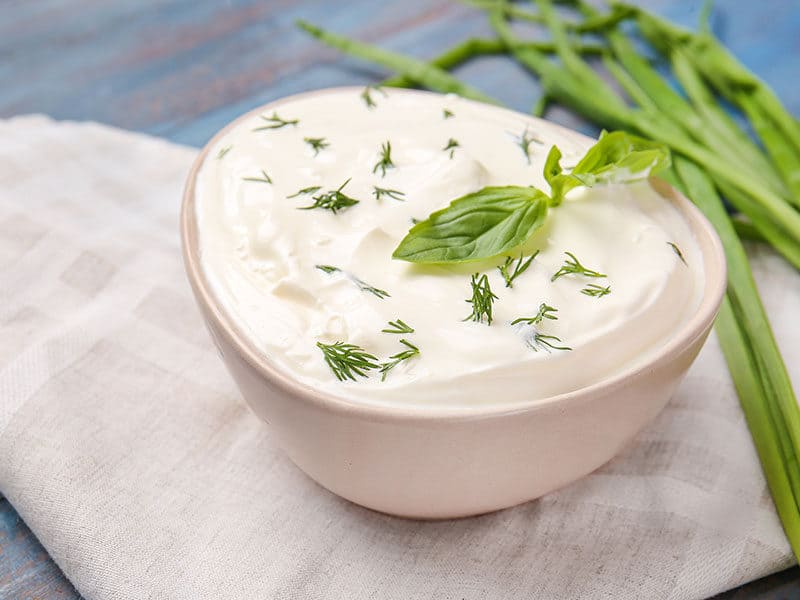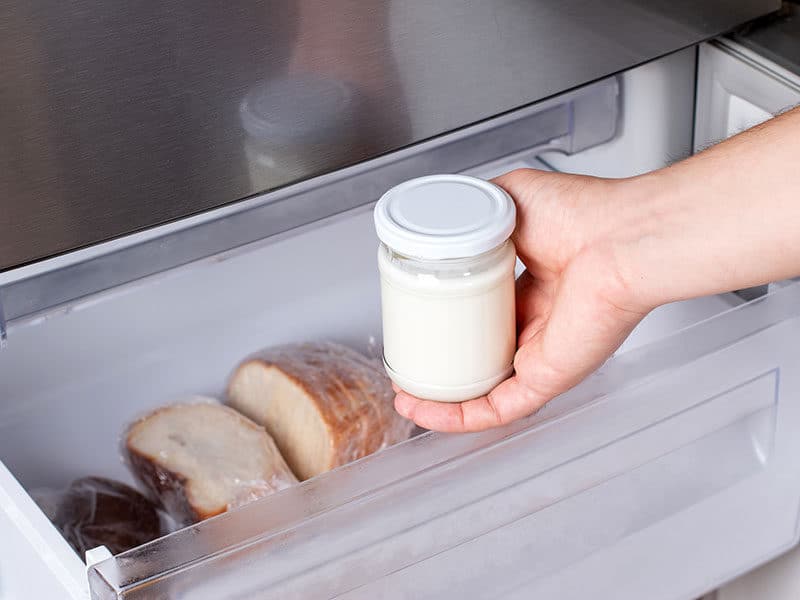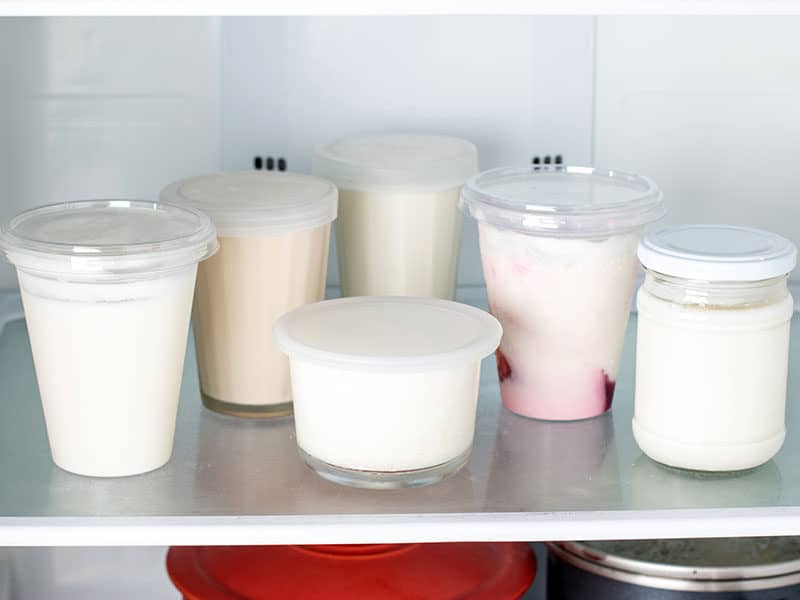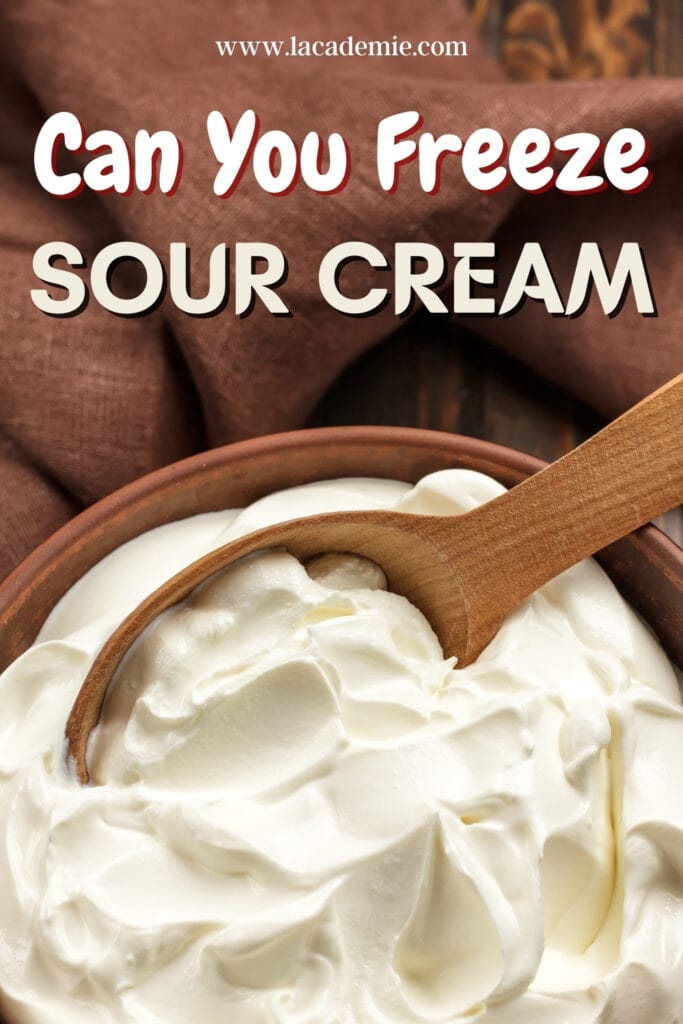Did you find a spoiled container of sour cream in your fridge again and wonder whether you can freeze sour cream the next time to avoid wasting food?
It often happens that one just needs a little bit of sour cream, and suddenly a container is open and will start to rot in the fridge. On the other hand, many people never think of freezing the rest of the sour cream.
However, in some instances, frozen dairy products can be brilliant, as you can keep them for a long time and never need to throw away spoiled cups, just because there has not been any other occasion to use them. Hence, read in this article in which instances you can freeze sour cream and how to do it the right way.

What Is Sour Cream?
Sour cream is a typical term for the kitchen, and most people who are regularly cooking have for sure used it a couple of times already. On the other hand, it is not so commonly used like milk or whipping cream, which means that most people buy it only if they require it for a specific recipe.
You can use sour cream in place of mascarpone cheese if it is too hard to find. In fact, sour cream is quite versatile as other ingredients’ replacement, including some sorts of cheese or corn starch.
Surprisingly, sour cream is not much different from regular cream. Whipping cream is the base ingredient. It is fermented with certain types of lactic acid bacteria, which will make the cream slightly sour and thick.
“Does sour cream contain gluten?” you might ask. If you’re sensitive to gluten, I have good news for you. Most of the time, sour cream is gluten-free. However, it’s always best to check the label before buying.
It is very commonly used to be eaten with baked potatoes, while also added to chili con carne dishes, to make sauces and served with berry fruits. It is also used to create dips or various dishes to pair with burgers, French fries, or Mexican dishes such as Tacos or Enchiladas.

Can You Now Freeze Sour Cream?
While it sounds like a simple question, it is actually not as simple to answer. However, it is easy to say that frozen dairy products such as cream cheese, lactose-free yogurt, and sour cream will irreversibly change their consistency.
But the key difference between yogurt and sour cream is yogurt can freeze well while freezing sour cream has to take other considerations.
It is, however, still possible to freeze sour cream, as the product itself does not go wrong; it is just not that suitable anymore for all purposes. Hence, if you have a cup open and don’t think you will consume it within the next three days, I would always put it in the freezer.
In general, you can use frozen sour cream very well if you heat it again. This means it is perfectly functional to cook sauces or desserts and may also work well in baked pies, pizza, or the French Tarte flambé.
If, on the other hand, you are planning to consume it without a cooking or heating process, such as garnishing baked potatoes or chili con carne, you better not use the frozen cream and buy a new container of sour cream instead.
This is due to the fact that, as previously mentioned, the consistency will change. While hygienically safe, it may crystallize and turn out grainy with the different ingredients, not making a homogenous mixture anymore.
How To Freeze Sour Cream The Best Way
If you want to give it a try, let me provide you with a few handy tips to freeze sour cream with the best results.
General Tip: Act Soon!
Always freeze sour cream as soon as possible. Once you foresee that you will not be able to consume it at once, freeze it. The fresher it is at the freezing time, the longer you can keep it in the freezer. If you freeze it on its expiration day or when it starts to lose its quality already, you cannot keep it very long in the freezer either.
Method 1: Freezing an Unopened Container
Perhaps you have bought too much sour cream the last time and still have one or two containers unopened in your fridge, and they soon reach the expiration date. If so, placing them in the freezer is extremely simple.
Most of the time, sour cream comes in similar packaging to yogurt, small plastic cups with an aluminum foil lid, sometimes a plastic cover on top. However, another seldom package option is a small carton box, similar to milk or juice containers.
Both package options are great to be placed in the freezer precisely as they are. When placing them in, make sure they stand on an even surface and cannot tip over if you move the drawer.
Especially with the plastic cups, you need to be a little careful as they are easy to tear. Hence, store them away from other packages with relatively sharp edges, such as meat packed in plastic containers.
As you are freezing the original container written on the package with its expiration date, there is no need to create a label. You can use the printed “use by” date as an orientation to help you remember for how long it is sitting in the freezer already.
Method 2: Freezing Opened Containers
Freezing sour cream that has already been opened is a little more complex but nothing to worry about. You can use the original container, but I recommend using a best-rank freezer-safe container with an airtight lid. These products would be better to store your food.
The consistency will still change, but a little less intense than if you freeze it in the original container, as you cannot lock it airtight. Before placing it in the freezer, stir it around with a teaspoon to make sure that all different ingredients are mixed as perfectly as possible.
If the cup was standing in the fridge for a little, moisture has formed, and it could even have happened that the ingredients have started to separate. Hence, if you stir it around again, you are creating an even mixture again.
If you use the original cup, try to seal it using aluminum foil and press it as hard as possible onto the container’s top edge. However, keep in mind that this self-made lid is neither air-, nor waterproof.
Hence, you need to make sure that the cup cannot tip over or tilt, as otherwise, the cream may flow out if it will tip over before it is frozen. It is best to place it in the corner of a drawer and then have some other not-sharp items nearby, keeping it standing upright.

Extra Tip: Freeze In Portions
If you are planning to use it to make sauces and only need a small amount every time, it is a good idea to divide it into servings now before freezing. Once it is frozen, it is impossible to separate it immediately, and you have to defrost the entire cup, even if you only need one tablespoon.
Then you will most likely have a similar problem again where you will have leftover cream, but then the freezing option is gone (read why further down).
If you have placed it into the freezer close to the container’s expiration date and use the original container, then there is no need to label it. If you have filled the sour cream into your own container, I recommend creating a label stating that it is sour cream and the date you have frozen it.
How Do I Defrost Sour Cream?
If the day comes where you need your sour cream to cook a soup, sauce, or bake a pie, then you can adhere to these few simple points to make the cooking process a little smoother.
Ideally, you know already a few hours before that you will need the sour cream. Then, you can take it out from the freezer and simply place the container into the fridge.
The soft change of temperature is much better for the consistency and taste later on and is always the preferred method. Before adding it to your meals, please give it a deep stir, as sometimes, the different ingredients which have separated will actually mix back into a homogenous liquid.
If, however, you have not remembered that you will need it, then, of course, you have no other choice than to throw the frozen cream into your food. In this event, if you are stirring it into a soup or sauce, reduce the temperature of the pot to a low level and slowly stir it in. Keep stirring for a long time until it has completely melted.

Important! Do Not Defrost At Room Temperature!
Unfortunately, many people defrost frozen food by simply placing the container somewhere in the kitchen, sometimes exposed to sunshine, to accelerate the thawing process. This is a terrible idea!
The top surface of the sour cream will quickly reach a temperature between 10 and 15 degrees C (50 to 59 F), later 20 (70 F), and more, which is the perfect base for various bacteria to resume growing again.
Against the belief of many people, the freezer does not kill most of the bacteria. Instead, they just fall into a stage where they interrupt being active, which means they are no longer consuming any food and are not reproducing.
However, they survive the cold temperatures and become active again as soon as you take the food out from the freezer. Once the temperature of the sour cream exceeds 10 degrees (50 degrees F), they reach the maximum reproduction pace, which means that the sour cream will soon be spoiled.
If possible, you should use a high-ability defrosting tray, and this will be a clean surface in contrast to the package.
Bonus Tip: Cornstarch
If you notice that your sour cream is not as thick as before freezing, there is a secret trick to bring it back to its original texture. Simply mix a little cornstarch into the sour cream. Stir well and always add only a very small amount until the mixture has reached the desired thickness.
If you give a lot of cornstarch and you thereby lose the sour taste, you can add a few drops of lemon juice. This will offset the starch and will bring back the touch of a sour taste.
How Long Can I Store Sour Cream?
Like most other dairy products such as cream cheese with its specific shelf life in the fridge, sour cream should always be kept refrigerated and never at room temperature.
The exact minimum and maximum temperatures are most of the time written on the packaging, but you can place it anywhere in your fridge.
Storing An Unopened Container
Next, the expiration date, sometimes also stated as “sell by” and “use by,” gives a good indication of how long you can store an unopened container in your fridge.
Usually, the manufacturers calculate these days with a bit of extra margin as they have to guarantee the product’s freshness until this date.
Hence, a sour cream that has been correctly stored in the fridge all the time can often still be consumed a day or two beyond the expiration date. Scroll a little down to see how you can check whether it is still good to consume.
Storing An Opened Container
Once you open the container, most manufacturers tell you to consume it immediately. Again this is as they do not want to become reliable for any potential food poisoning. However, you can ideally store an open container in your fridge for at least three days, as long as you open it, not on its expiration day.
If you cover the container again with aluminum foil or fill the sour cream into a sealable box, you can even keep it for about one week. I would always recommend storing it as airtight as possible as this will preserve the texture and consistency.
In general, if you add the sour cream to a dish that you are boiling, such as a soup or a sauce, you do not need to be as sensitive while when you consume it uncooked, I will not consume it if it has been open for more than five days.
How To Check If Sour Cream Is Still Safe To Use?
In case you are unsure about whether you can use an open sour cream or a container that has exceeded its expiration date, you can make use of the following checks:
Color Check:
Sour cream always has to be in a very creamy, white color. If you see it is getting even just a little darker or becomes to get yellow spots, you should throw it away, unfortunately.
Smelling Check:
If your cream has passed the color test, then smell it. Bring your nose as close as possible and take a deep breath in. If you notice a strong, unpleasant odor in a way that your arms are pushing the cup back from your nose as a reflex, it is certainly time to throw the container away. If you do not smell anything, proceed to the next test.
Taste Check:
If so far you have not noticed anything odd, and then you can go ahead and taste a little bit of it. Take the front of a teaspoon and dip it into the cream, then taste it. If the taste deviates from what you are used to, I will discard the sour cream.
If your sour cream has passed all the tests, it is still safe to use, and you can go ahead using it.
FAQs About Freezing Sour Cream
If there are still some open questions in your head, I guess you will find answers in the FAQ section below.
Expectation Vs. Reality
As I have mentioned freezing sour cream is not as easy as freezing cakes or grilled meat. Most likely, the texture will be destroyed, and you can only use it to process it into other dishes, but you most likely will not be able to use it as a garnish for baked potatoes or berries.
Nevertheless, above, you find an extensive range of options on how to use, freeze, and defrost it. If you follow the advice, I am sure that you will be able to use your sour cream and do not have to throw it away, reducing food waste.
Leave us a comment on how it worked out for you and whether this article was helpful for you. I am curious to hear what you have used the sour cream after freezing and whether you noticed a difference between fresh and frozen cream.
Good Luck!


